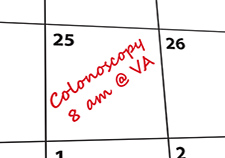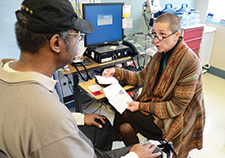Office of Research & Development |
 |

VA Research Currents archive
February 26, 2016

A study at the White River Junction VAMC in Vermont compared colonoscopies performed at that facility to those done at outside facilities to which the VA patients were referred. (Photo illustration by Michael Escalante)
A study at one VA medical center found that the detection rate for potentially precancerous polyps—a key measure of colonoscopy quality—was substantially higher among patients whose procedures were done in VA than among similar VA patients who were referred out for colonoscopy to private facilities.
The study, performed at the White River Junction VA Medical Center in Vermont, may not be representative of all VA medical centers.
"I don't want to negate our results, but it's difficult to generalize our findings," said Dr. Heiko Pohl, the study's senior author. Pohl is a researcher and gastroenterologist at the White River Junction VAMC and the VA Outcomes Group, and an associate professor at Dartmouth's Geisel School of Medicine and the Dartmouth Institute.
The study appeared online in Gastrointestinal Endoscopy on Jan. 16, 2015. Pohl's coauthors were Drs. Douglas Robertson, also with the White River Junction VA; and Michael Bartel, of the Mayo Clinic.
The main outcome measure of the study was what gastroenterologists call the "adenoma detection rate," or ADR. An adenoma is a type of polyp, or growth, that occurs on the lining of the colon. Adenomas can harbor cancer, or turn cancerous. Doctors snip them out during a colonoscopy and send them to the lab to be biopsied.
"On the whole, our findings suggest there's good quality inside and outside."
Colorectal cancer is the third most common cancer in the U.S. It is also the second leading cause of cancer deaths, behind lung cancer. VA diagnoses some 4,000 new cases of the disease each year in Veterans.
The Vermont study involved 818 patients in all, almost all men, between ages 50 and 85. Half underwent a colonoscopy at the White River Junction VAMC. The other half had their procedures at an outside facility.
The White River Junction VA, like other VA medical centers, has contracts in place that allow it to refer patients to outside providers for certain services, at VA's expense. This was the case even before the passage of the 2014 Veterans Choice Act.
Nationally, about a third of VA patients who undergo colonoscopies have them at outside facilities.
Pohl's study included patients who had procedures between 2007 and 2010. He says during this time, only about 10 percent of the colonoscopies done for White River Junction VA patients were performed at outside facilities.
He says the White River Junction VA generally tries to handle all colonoscopies in-house, but during times of peak demand, the facility will give Veterans an option to go to an outside provider.
The study found that the ADR for patients referred to outside providers during the study period was 38 percent. In other words, the procedures detected at least one adenoma, or polyp, in 38 percent of the 409 patients referred to the outside facilities, which included 30 nonacademic centers and 2 academic, or teaching, hospitals.
In comparison, the ADR among those patients who had a colonoscopy at the VA hospital was 52 percent. The patients were matched on age, gender, and year of procedure to the group that had the test done outside.
Both figures represent good care, stresses Pohl.
"On the whole, our findings suggest there's good quality inside and outside," he says. "No matter where patients got their colonoscopy, the quality benchmarks were reached."
Under U.S. guidelines, an ADR of at least 30 percent is the quality benchmark for men age 50 or older. An ADR below that could indicate that physicians are not doing a careful or thorough enough job when they slowly work the scope through the colon to look for growths.
In a related outcome measure of the study, the "advanced ADR" among the VA-colonoscopy group was 22 percent, compared with 13 percent among those Veterans who had the test done outside. This refers to the percentage of patients whose procedures detected at least one large adenoma, or other higher-risk patterns.
The study also found that the average number of adenomas per patient was lower in the outside group than in the VA group—0.72 versus 1.41.
Pohl says the whole question of colonoscopy quality can get quite nuanced and complicated. For example, some experts recommend higher baseline ADR rates for populations at higher risk for colorectal cancer—say, African Americans. Another factor is whether "more is better" when it comes to catching polyps. Very small ones—those under 5 millimeters wide—are very unlikely to have cancer in them or turn into cancer. Yet they account for the vast majority of polyps that are removed and biopsied.
"We don't know how important it is to find more and more adenomas," says Pohl. "It's not clear whether there's a ceiling effect. At a certain point, this may not add any benefit, but it may add risk and costs. It may identify patients to be at risk who are not really at risk. It could lead to over-diagnosis and over-treatment."
Such discussions aside, Pohl says that for now among gastroenterologists, "we all strive to find more adenomas. A higher ADR means a better colonoscopy. That's the bottom line."
His group's study also looked at how well his VA and the outside facilities adhered to surveillance guidelines. Basically, this refers to how long patients are advised to wait till their next colonoscopy. The interval generally ranges from 3 to 10 years, depending on the findings from the current procedure, and, on that basis, the extent to which the patient is considered at risk for colorectal cancer.
The study found that 80 percent of recommendations at the outside facilities adhered to the guidelines, compared with 87 percent at the VA hospital.
In a related measure, those recommendations were properly documented in 74 percent of cases on the outside, versus 93 percent of the time in VA.
Despite the favorable showing by the White River Junction VA, other research has found wide variation in how well VA physicians adhere to colonoscopy interval guidelines. A 2015 study of several VA sites by a group at the Durham VA Medical Center and Duke University found that more than a third of patients received recommendations for a repeat colonoscopy at an interval sooner than what the guidelines call for. This could unnecessarily raise patient risk and costs. The researchers called for targeted education to endoscopists to help address the issue.
Pohl says he is curious to learn more about the factors that drive quality differences between VA and non-VA facilities that perform colonoscopies, as well as the differences among VA sites. A larger study now underway by his group and VA collaborators in Indianapolis may shed some light on those questions. The main goal, though, is to look at how effective colonoscopy is at preventing deaths from colorectal cancer. Using national data, the team will look at how VA medical centers vary in their use of colonoscopy, and whether more intensive use of the test for screening and surveillance is indeed associated with lower death rates.

CONFIRM study coordinator Elaine Nevins explains a colorectal cancer screening procedure to Navy Veteran Alex Pryor at the VA Puget Sound Health Care System. (Photo by Christopher Pacheco)
In February 2016, the Canadian Task Force on Preventive Health came out with new guidelines that advise against the use of colonoscopy for routine screening for colorectal cancer in those with no symptoms or family history of the disease. The group favors, instead, stool-based chemical tests, or a somewhat less invasive procedure called flexible sigmoidoscopy, which examines only the lower third of the colon. The Canadian experts cite VA's large multisite CONFIRM trial as one of the important studies now underway to gain more clarity about the pros and cons of colonoscopy versus stool-based testing.
CONFIRM aims to enroll up to 50,000 Veterans at 42 VA medical centers over the next two to three years and follow them for a decade to track deaths, cases of colon cancer, and other outcomes.
CONFIRM researchers will compare two screening methods. One is colonoscopy, still considered by most U.S. experts to be the gold standard for early detection of the disease. But the procedure is invasive and costly, and occasionally causes complications, such as a tear in the intestines.
The other method is fecal occult blood testing (FOBT), a simple test in which a small plastic device is used to sample feces, which is then checked in the lab for signs of hidden blood. The study will use a relatively new form known as fecal immunochemical testing (FIT). The test has its pluses, but the extent of its effectiveness in reducing mortality is unclear.
For adults age 50 or older who have no symptoms of colorectal cancer and no family history of the disease, most U.S. screening guidelines—including VA's—recommend either FOBT every year or colonoscopy every 10 years. It is those two approaches that CONFIRM is comparing. A third option some patients choose is sigmoidoscopy every five years, along with FOBT every three years.